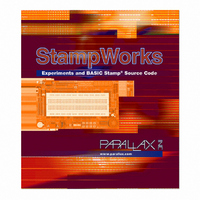27220 Parallax Inc, 27220 Datasheet - Page 195

27220
Manufacturer Part Number
27220
Description
BOOK STAMPWORKS
Manufacturer
Parallax Inc
Datasheet
1.27220.pdf
(230 pages)
Specifications of 27220
Accessory Type
Booklet
Product
Microcontroller Accessories
Lead Free Status / RoHS Status
Not applicable / Not applicable
For Use With/related Products
StampWorks
Lead Free Status / RoHS Status
Lead free / RoHS Compliant, Not applicable / Not applicable
- Current page: 195 of 230
- Download datasheet (3Mb)
Moving Forward · Page 185
There is a brief period when the Slave device can take control of the SCL line. If a
Slave is not ready to transmit or receive data, it can hold the SCL line low after the
Start condition. The Master can monitor this to wait for the Slave to be ready. At
the speed of the BS2, monitoring the clock line usually isn't necessary but the
capability to monitor “clock hold” is built into the I2C_Start subroutine just to be
safe.
For our experiments we'll be using 7-bit addressing (see figure below) where the
upper seven bits of the slave address byte contain the device type and address, and
bit zero holds the data direction: "0" indicating a device write; "1" indicating a device
read. What follows the slave address will vary, depending on the device and the
type of request. Most I2C devices have one or two address bytes which will be
followed by the data byte(s) to write to or read from the device
Data is transferred eight bits at a time, sending the MSB first. After each byte, the
I2C specification calls for the receiving device to acknowledge the transmission by
bringing the bus low for the ninth clock. The exception to this is when the Master is
the receiver and is receiving the final byte from the Slave. In this case, there is no
Acknowledge bit sent from Master to Slave.
Sending and receiving data from a specific slave always requires a Start condition,
sending the Slave address and finally, the Stop condition. What happens between
Related parts for 27220
Image
Part Number
Description
Manufacturer
Datasheet
Request
R

Part Number:
Description:
Microcontroller Modules & Accessories DISCONTINUED BY PARALLAX
Manufacturer:
Parallax Inc

Part Number:
Description:
BOOK UNDERSTANDING SIGNALS
Manufacturer:
Parallax Inc
Datasheet:

Part Number:
Description:
COMPETITION RING FOR SUMOBOT
Manufacturer:
Parallax Inc
Datasheet:

Part Number:
Description:
TEXT INFRARED REMOTE FOR BOE-BOT
Manufacturer:
Parallax Inc
Datasheet:

Part Number:
Description:
BOARD EXPERIMENT+LCD NX-1000
Manufacturer:
Parallax Inc
Datasheet:

Part Number:
Description:
CONTROLLER 16SERVO MOTOR CONTROL
Manufacturer:
Parallax Inc
Datasheet:

Part Number:
Description:
BASIC STAMP LOGIC ANALYZER
Manufacturer:
Parallax Inc
Datasheet:

Part Number:
Description:
IC MCU 2K FLASH 50MHZ SO-18
Manufacturer:
Parallax Inc
Datasheet:














